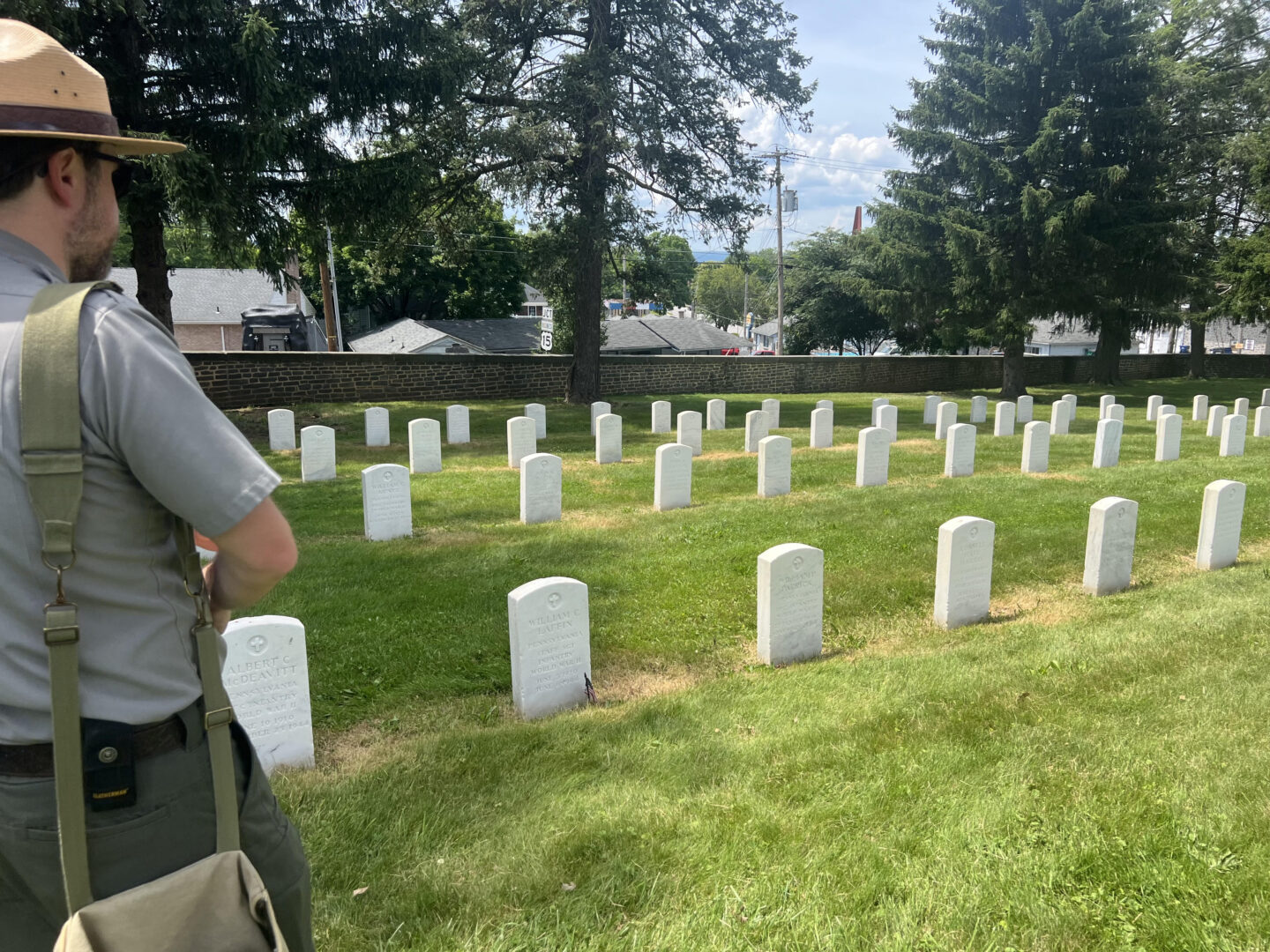
National Park Service ranger Daniel Vermilya looks at graves marking Pennsylvanians who were killed during the D-Day invasion. The NPS is holding events to commemorate the event for the 80-year anniversary.
Katie Knol / WITF

National Park Service ranger Daniel Vermilya looks at graves marking Pennsylvanians who were killed during the D-Day invasion. The NPS is holding events to commemorate the event for the 80-year anniversary.
Katie Knol / WITF

Katie Knol / WITF
National Park Service ranger Daniel Vermilya looks at graves marking Pennsylvanians who were killed during the D-Day invasion. The NPS is holding events to commemorate the event for the 80-year anniversary.
The National Park Service is remembering 13 Pennsylvanians buried at the Gettysburg National Cemetery who died during the D-Day invasion 80 years ago.
Twelve of the men were killed during the landing on Omaha Beach — Clairus Riggs, Richard Brandtonies, William Laffin, Byron Stanton, George Hawn, Alfred Augustine, Howard Nutt, William Copeland, Forrest Rice, Elmer Warman, Frank Kvasnosky and John Clister. Joseph Fedish died on Utah Beach. They were part of the largest amphibious invasion in military history as Allied forces landed on five beaches in Normandy.
Around 4,440 Allied troops were killed in action on June 6, 1944, including about 2,500 Americans.
Families were given the option of burying loved ones overseas or having their remains returned to the U.S.
Daniel Vermilya, a National Park Service ranger at Eisenhower National Historic Site in Gettysburg, said they might have chosen the national cemetery because it was the site of the famed Civil War battle and symbolizes a fight for freedom.
He said the men left their regular lives for a fight that was bigger than themselves.
“D-Day really was a battle for what the world would look like today, and I think a lot of the men fighting that day knew it,” Vermilya said.
One of Vermilya’s favorite stories is that of Staff Sgt. William Laffin of Clinton County, who served in the 29th Infantry Division. The unit landed on Omaha Beach.
“Laffin was an avid baseball player in his hometown of North Bend, Pennsylvania,” Vermilya said in a video shared on Facebook. “In fact, he was so good he even got a tryout with the St. Louis Cardinals before he joined the United States Army.”
The other men came from diverse backgrounds all across Pennsylvania. Riggs was a coal miner. Fedish was a baker. Some men were firefighters and boy scouts. Vermilya noted they were very active in their communities.
He said a major anniversary — like the 80th — shines a light the importance of the D-Day invasion. So, he sees it as a great opportunity for educators and historians to bring the stories of the common soldier to life.
“You start talking about the broader war effort — that D-Day wasn’t just the 101st Airborne,” he said. “It was an event that featured branches of services from all sorts of countries, and there was roles for women and African Americans with this as well. So it was a massive, massive undertaking.”
The Eisenhower Historical Site is offering special events over several days, including evening walking tours through the cemetery to talk about the men who paid the ultimate price in northern France, tours of the Eisenhower’s Gettysburg home, and living history programs.

Sometimes, your mornings are just too busy to catch the news beyond a headline or two. Don’t worry. The Morning Agenda has got your back. Each weekday morning, host Tim Lambert will keep you informed, amused, enlightened and up-to-date on what’s happening in central Pennsylvania and the rest of this great commonwealth.
The days of journalism’s one-way street of simply producing stories for the public have long been over. Now, it’s time to find better ways to interact with you and ensure we meet your high standards of what a credible media organization should be.